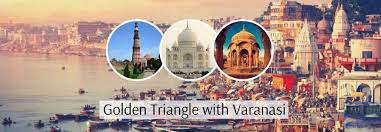
OVERVIEW
One of the most well-known travel routes in India is the Golden Triangle Tour, which visits Delhi, Agra, and Jaipur. An excellent method to discover India’s architectural and historical diversity is through this excursion. The trip is elevated by including Varanasi, India’s old spiritual center, which combines the country’s antique monuments with its profound spirituality. This six-day schedule encapsulates the spirit of this amazing adventure.
Why Pick Varanasi for Your Golden Triangle Tour?
Spirituality and Rich Cultural Diversity
You may get a sense of India’s amazing cultural and historical legacy by visiting Delhi, Agra, and Jaipur. Varanasi adds a spiritual component, completing the journey and encompassing India’s beauty and soul.
Exploration of Historical Wonders
Every city on this route has something special to offer, such as Varanasi’s holy river ceremonies, Agra’s romance with the Taj Mahal, Delhi’s dynamic blend of the old and the new, and Jaipur’s regal palaces. When combined, they provide a memorable experience.
Day 1: Reaching Delhi
Delhi, the capital of India, is where your journey starts. Delhi is a city where modernism, culture, and history all coexist. To experience the city’s disparate atmosphere, spend the first day of your stay touring both Old Delhi and New Delhi.
Highlights of India Gate, Jama Masjid, and Red Fort
Red Fort: A representation of Mughal opulence, this 17th-century fort is a UNESCO World Heritage site.
Jama Masjid: A tranquil haven, Jama Masjid is one of India’s largest mosques.
India Gate: The war monument is a lovely place to relax.
Day 2: Touring Delhi and Getting to Agra
Before traveling to Agra, begin your day by seeing some of Delhi’s historical and contemporary sites.
The Lotus Temple with Qutub Minar
Qutub Minar, Another UNESCO landmark, this 73-meter-tall minaret dates from the 12th century.
Lotus Temple is a Baháʼí House of Worship and a singular architectural wonder built like a lotus.
Take a picturesque drive to Agra after touring; the trip takes about three to four hours.
Day 3: Agra: The Magnificent Taj Mahal
Agra is commonly associated with the Taj Mahal, a UNESCO World Heritage monument and one of the Seven Wonders of the World. It is best to visit early in the morning to take in its splendor at dawn.
Visiting Mehtab Bagh and Agra Fort
The Mughals lived in the enormous red sandstone fort known as Agra Fort.
Mehtab Bagh: A lovely garden on the other side of the Yamuna River that is ideal for sunset views of the Taj Mahal.
Day 4: Journey from Agra to Jaipur, often known as the Pink City
Make a stop at the ancient city of Fatehpur Sikri on your way from Agra to Jaipur on Day 4.
Traveling to Fatehpur Sikri
With its palaces and mosques that attest to its illustrious past, this once-thriving Mughal capital is now a ghost city.
Arrival and Evening Activities in Jaipur
After arriving in Jaipur, spend the evening lounging at your hotel or touring the local marketplaces.
Day 5: Jaipur. Sightseeing Jaipur, also referred to as the “Pink City,” is well-known for its colorful architecture and royal history. Spend the entire day touring its most well-known sites.
Jal Mahal and Amber Fort
Amber Fort is renowned for its elaborate architecture and is a stunning fort perched on a hill.
The gorgeous Jal Mahal, often known as the “Water Palace,” is situated in the center of Man Sagar Lake.
The Jantar Mantar, City Palace, and Hawa Mahal
The famous “Palace of Winds,” with its distinctive exterior, is Hawa Mahal.
City Palace: A complex showcasing Jaipur’s royal past.
For those who enjoy science and history, Jantar Mantar is an ideal astronomical observatory.
Day 6: From Jaipur to Varanasi
Fly or rail to Varanasi from Jaipur. Known for its ancient temples and spiritual rituals, this city on the banks of the Ganges River is considered one of the holiest in Hinduism.
On the Ganges River, evening Aarti
Experience the Ganga Aarti, a complex river worship ritual held at Dashashwamedh Ghat, when you first arrive. An unforgettable sensation is created by the lights, incense, and chanting.
Day 7: A Day of Spirituality in Varanasi
Spend the day touring Varanasi’s historic sites and taking in the city’s serene ambiance.
Ganges morning boat ride
Take a Ganges boat ride to start the day. It is really spiritual to see the sunrise over the river and watch the people going about their daily lives.
Sarnath and the Kashi Vishwanath Temple See the temple of Kanish Vishwanath: This temple is one of the twelve Jyotirlingas and is devoted to Lord Shiva.
Sarnath: A significant location for Buddhists, Sarnath is located just outside of Varanasi and is where Buddha delivered his first discourse.
To sum up: A Spiritual and Cultural Adventure to Remember
India’s rich cultural, historical, and spiritual heritage can be experienced through the Golden Triangle Tour with Varanasi. This trip encapsulates India’s spirit, from the busy streets of Delhi to the tranquil ghats of Varanasi.
FAQs
When is the best time to visit Varanasi and do the Golden Triangle Tour?
The best months to go are October through March, when the weather is nice.
What is the average cost of this tour?
Although prices vary, be prepared to spend between $700 to $1200 each person, which includes lodging, guided excursions, and travel.
Is traveling alone safe?
Yes, but for a safer trip, always abide by local regulations and pick reputable tour companies.
What should I bring on this tour?
Sunblock, a hat, comfortable clothes, walking shoes, and any other items necessary for a variety of conditions.
Would it be possible for me to alter this schedule?
Yes, definitely! Numerous travel companies provide packages that can be altered to accommodate individual tastes.







